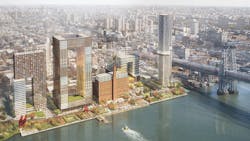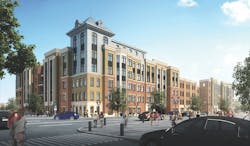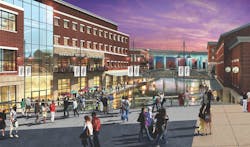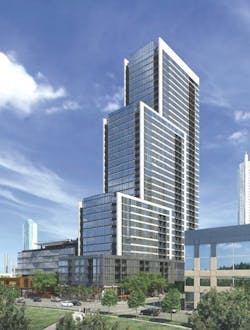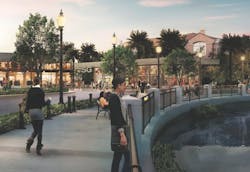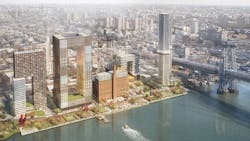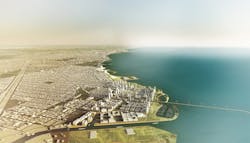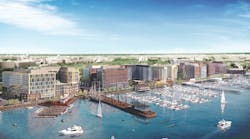9 mega redevelopments poised to transform the urban landscape
Slowed by the recession—and often by protracted negotiations—some big redevelopment plans are now moving ahead. Here’s a sampling of nine major mixed-use projects throughout the country.
1. Riverbend District, Harrison, N.J.
Developer: Advance Realty
The scope: Eighty acres of brownfield redevelopment across the Passaic River from Newark, a 20-minute PATH train ride from New York City. The waterfront site is slated to include retailing, offices, residential, hospitality, and park projects.
The story: Previously known as the MetroCentre, this former industrial zone consists of remediated land once used for steel-pipe manufacturing. Riverbend is part of a larger Waterfront Redevelopment Project: a plan to revitalize 250 acres, or about a third of the city. Progress has been slowed by the recession, by delayed expansion of the PATH station (now under way), by Superstorm Sandy, and by a tax battle between Harrison and the New York Red Bulls soccer team, which occupies an arena that opened adjacent to Riverbend in 2010. Much of the dust has now settled, and mixed-use projects are moving once again. Advance just completed a 48,500-sf build-to-suit tech center for Panasonic Corp. of North America in Riverbend’s “North Pad” section, consisting of engineering offices, lab space, and testing facilities.
What’s next: Officials hope continued development—abetted by generous, if sometimes controversial, tax financing—will enable a larger city revitalization over the next decade. Ironstate Development, Pegasus Group, Heller Urban Renewal, Steiner Equities, and Russo Development are all building residential properties in the redevelopment zone, and a Starwood Element hotel will open this year. Within Riverbend, Advance plans a Q1 groundbreaking for Phase 1 (139 units) of a 345-unit multifamily development, including 18,000 sf of retail space, plus parking. Approvals are in place for two future Advance residential buildings of 296 units apiece, and the company has sold one Riverbend block to Russo, which already has a 393-unit apartment building under construction.
2. Canalside, Buffalo, N.Y.
Developer: Erie Canal Harbor Development Corporation (a subsidiary of Empire State Development, a state agency)
The scope: Twenty-one acres where the western terminus of the Erie Canal meets the Buffalo River, encompassing up to 1.1 million developable sf of cultural, entertainment, retail, commercial, and residential uses. A combination of public and private investments totaling $460 million is projected.
The story: Buffalo is in the midst of a rebirth, symbolized by the burgeoning Buffalo Niagara Medical Campus and a new med school for the University at Buffalo. The Erie Canal Harbor Development Corporation was founded in 2005 with the goal of stimulating the city’s economy by leveraging its historic—but dilapidated—waterfront. Demolition, remediation, and basic infrastructure improvements were completed in 2008, and EE&K, now part of Perkins Eastman, created a master plan.
Outdoor concerts, plays, and a kayak and water bike facility are already drawing nearly a million visitors a year to Canalside, which is accessible by foot, bicycle, car, and boat. Benderson Development just finished the district’s first private-sector project: One Canalside, a $30 million adaptive reuse of a former state office building for a Courtyard by Marriott, four floors of offices, and ground-level retailing. Next door, ECHDC’s newly completed East Canal project recently created a $5 million public park.
What’s next: The EDCHD Board has approved a plan to fund core-and-shell construction for two facilities and full build-out of a third (including a restaurant and children’s museum) on the South Aud Block, one of Canalside’s most prominent parcels. The agency is also proceeding with street improvements, bike trail amenities, a boat and kayak launch, parking, and interpretive signage. The $23 million Public Canals project, which realigns waterways with the historic canal at the site of the former Memorial Auditorium, will be finished this year. City officials hope to implement a far larger Inner Harbor Plan, including additional residential and mixed-use districts.
3. GreenWater (Block 1), Austin, Texas
Developer: Trammell Crow Company (joint venture with The Hanover Company)
The scope: The overall GreenWater development encompasses five city blocks. Potential uses include offices, retail, residential, hospitality, assisted living, and public green space. Over the years, about 1.75 million sf of facilities has been discussed for the site.
The story: Austin has been preparing to redevelop the former Thomas C. Green Water Treatment Plant—one of two large mixed-use projects to be created on outdated city infrastructure sites—for a decade. The city entered into a master development agreement with TCC in 2012. Solomon Cordwell Buenz is designing Block 1, the first of four phases now envisioned. The proposed 38-story mixed-use building would include 436 apartments atop street-level stores, plus office space.
What’s next: Groundbreaking is projected for Q2, with completion in 2015. The build-out schedule for the entire parcel remains tentative. Development at the nearby decommissioned Seaholm Power Plant is also under way, with a 30-story luxury condo tower expected to be ready by the first quarter of 2015. (Seaholm Power LLC and CIM Group are working with Urbanspace Real Estate on that project.)
4. Hollywood Park Tomorrow, Inglewood, Calif.
Developer: Wilson Meany and financial partner Stockbridge Capital Partners, dba Hollywood Park Land Company
The scope: A 238-acre community anchored by a renovated 100,000-sf casino, approved for 2,995 residences (condos, townhouses, and single-family homes), a 620,000-sf shopping district with a movie theater and restaurants, a 300-room hotel, up to 75,000-sf of offices, 25 acres of parkland, and four acres reserved for civic use.
The story: The development team bought the fabled Hollywood Park horse track from owner Churchill Downs more than eight years ago for $254 million. In 2009, the city approved entitlements essential to executing a master plan created by Cooper, Robertson & Partners. However, the anemic economy has delayed action. The proposed “green community” would ultimately require an estimated $2 billion investment. Participants already on board include BCV Architects, Quarto Design Group, SWA Group, and Mia Lehrer & Associates.
What’s next: The developer advised the state racing board that fall 2013 would be the track’s final season—a sign that change is imminent. Decommissioning of the track, and demolition of everything but the existing gaming facility, are scheduled for Q1. Once the site is cleared, contractors will start the initial phase of retail construction, parks, and residential pads that will be sold to merchant builders. Delivery of the first residential sections and retail stores is expected in 2016 and 2017, with complete site build-out by about 2021. (The Meany/Stockbridge team is also redeveloping San Mateo’s Bay Meadows racetrack for an 83-acre mixed-use community, a project ongoing since 2003.)
5. New Domino, Brooklyn, N.Y.
Developer: Two Trees Management Company
The scope: Eleven acres in the Williamsburg neighborhood, encompassing an estimated $1.5 billion investment in 3.3 million sf of residential, office, and commercial space. The central element is a Domino sugar refinery that operated from the 1880s to 2004.
The story: Purchased in 2004 by developers CPC Resources and Katan Group, the prominent property on the East River was previously the target of a city-approved master plan by Rafael Viñoly Architects. The deal fell apart in 2010, and current developer Two Trees—which has a strong track record in remaking old industrial blocks into Brooklyn’s trendy DUMBO neighborhood—bought the site shortly thereafter. A new master plan by SHoP and James Corner Field Operations includes adaptive reuse of a landmarked Domino building for offices. Four new residential-commercial towers of up to 55 stories are also planned, reflecting the scale of the nearby Williamsburg Bridge. Two Towers aims for neighborhood appeal with a school, a recreation center, more than 5 acres of parkland including a quarter-mile of waterfront green space, and 660 affordable apartments, or about a third of the total units. The developer says the current design, which calls for fewer but taller buildings than the prior master plan, ensures more open space and better access to amenities for all residents.
What’s next: Another round of civic approvals. Two Trees hopes to start construction this year.
6. Lakeside, Chicago
Developer: Chicago Lakeside Development LLC (a joint venture between McCaffery Interests and US Steel)
The scope: Encompassing the site of US Steel’s former South Works plant and surrounding neighborhoods, this 600-acre parcel with spectacular views of downtown and Lake Michigan is being master planned by SOM as a super-green mixed-use community. The developer projects more than 13,000 residential units, 17.5 million sf of retail, 125 acres of parkland, a 1,500-slip marina, and a new public high school.
The story: The South Works shut down in 1992, and Chicago officials, US Steel, McCaffery, SOM, community groups, and other partners have been working on remediation, and plans for a new neighborhood, ever since. The city’s South Shore is sorely in need of an economic reboot; Phase 1 redevelopment, a 76-acre “Market Common” with a mix of housing, offices, and retail, is intended to help provide critical mass. Research facilities are also proposed, perhaps related to the LEED-ND community’s advanced infrastructure. Plans call for a complete new utility system for sustainable power, heating, and cooling, including creative use of cogeneration, lakewater cooling, and waste recycling. Developers are also trying to persuade Barack Obama to choose the site for a future presidential library.
What’s next: The city approved $98 million in RDA and TIF funding for Phase 1 in 2010. A two-mile extension of South Lake Shore Drive, a crucial enabling development connecting Lakeside to downtown Chicago and points north, was completed late last year. McCaffery Interests’ Chairman/CEO Dan McCaffery reports active negotiations with building developers, particularly in the research and retail sectors. A complete build-out could take more than 30 years.
7. The Wharf (Southwest Waterfront), Washington, D.C.
Developer: Hoffman-Madison Waterfront (joint venture of PN Hoffman & Associates and Madison Marquette), in partnership with the District of Columbia
The scope: Twenty-seven acres on the Washington Channel adjacent to the National Mall, as well as 52 acres of water from the Municipal Fish Market to Fort McNair. An investment of $2 billion and a total of 3.2 million sf is planned, plus public open space. Phase 1 will encompass about 1.5 million sf, including offices, residential units, three hotels, shops, restaurants, three piers, and a three-acre waterfront park.
The story: The Southwest Waterfront, once a bustling zone of warehouses, docks, and tall ships, was an active commercial site for more than a century. As with many urban harbors, it fell into decay as transportation and shipping patterns changed, becoming isolated from the rest of D.C. due to interstate highway construction. The multi-agency Anacostia Waterfront Initiative was created in 2000 to hash out a framework for development. The master plan by EE&K (now part of Perkins Eastman) calls for about a dozen mixed-use buildings, ranging from two to 12 stories. Offices will be a primary use (960,000 sf is projected), along with 680 hotel rooms, 1,300 residential units (sale and rental), parking, and a flat-floor, 6,000-capacity music hall that fills a needed niche among local venues. Water-based development will include a marina, 550 boat slips, and four public piers. Developers emphasize that the LEED-ND Gold project is being planned as a local neighborhood first and a tourist attraction second.
What’s next: The DC Zoning Commission approved the first phase in January 2013, followed by federal approval last summer. Phase 1 will break ground this year, including entertainment venues, about 900 residential units, two office buildings, 200,000 sf of retail, and a 278-room Intercontinental Hotel. Developers hope occupancy will begin by mid 2017. Phase 2, completing the build out, should commence in 2018.
8. North Carolina Research Campus/Community, Kannapolis
Developer: Castle & Cooke
The scope: This 350-acre property, formerly the site of a textile mill, was acquired in 2004 by David H. Murdock, Chairman and owner of Dole Food Company. Murdock also owns Castle & Cooke, which is developing a billion-dollar campus consisting of research, medical, commercial, civic, and residential projects.
The story: Situated 20 miles north of Charlotte, the NCRC has seen steady construction of lab and support buildings since 2008. Nine universities, the private David H. Murdock Research Institute, and multiple companies—including Dole, General Mills, and Monsanto—are doing research at the site, focused on human health, nutrition, and agriculture. Rowan-Cabarrus Community College’s biotech and nursing programs are also now based at the campus. But the NCRC, with about a million sf already built, goes far beyond the typical research park, particularly in terms of government participation and mixed-use dreams. Carbarrus Health Alliance, the region’s public health agency, opened a facility there in 2012, and a medical center run by Carolinas HealthCare System was completed last summer. The master plan by Creech & Associates projects an entire community in the Georgian style established by the historic mill, encompassing housing, retail facilities, and parks.
What’s next: Kannapolis broke ground late last year on a new city hall and police station for which Murdock donated campus land. The 100,000-sf facility makes a strong statement regarding the identification of the city with the campus. DataChambers is building a 50,000-sf data center to serve the NCRC and other regional clients. According to David Creech, AIA, head of Creech & Associates, multifamily construction will also move ahead in the near future, with associated retailing down the line.
9. Essex Crossing, New York City
Developer: Delancey Street Associates (a joint venture composed of L&M Development, BFC Partners, and Taconic Investment Partners). Collaborating partners include The Prusik Group, Grand Street Settlement, and Educational Alliance.
The scope: Six acres previously known as the Seward Park Urban Renewal Area, on New York’s Lower East Side. Plans call for a $1.1 billion investment encompassing 1.9 million sf of facilities, including about 1,000 apartments, a school, a community center, retail stores, offices, a movie theater, a bowling alley, a market, parks, and a museum showcasing the works of Andy Warhol.
The story: Long eyed as a development target, this site has been vacant since tenements were demolished in the late 1960s. The neighborhood has been the subject of lively debate between city officials, potential developers, and community groups—some of whom demanded that all new housing be reserved for low-income residents. Gentrification concerns were exacerbated by the 2007 construction of a 17-story luxury condo building nearby. The current plan, representing a compromise between the interest groups and former Mayor Michael Bloomberg, calls for 50% market-rate units and 50% affordable units, with formerly displaced residents receiving preferential placement. SHoP Architects and Beyer Blinder Belle have released images showing an abundance of green space, including parks, multi-level gardens, and landscaped pedestrian corridors.
What’s next: Now that approvals are in place, stakeholders predict that construction will begin in spring 2015, with build out by 2023.
